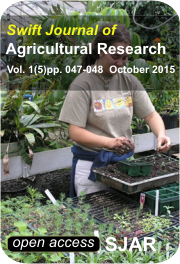Journal Categories

Swift Journal of Agricultural Research (SJAR)
October 2015 Vol. 1(5), pp. 047-048
Copyright © 2015 Swift Journals
Original Research Paper
Plant Polysaccharide Gels – Some Properties and Applications in Irrigation Systems, Horticulture and Soil Protection
Frank Mayer
Seerosenweg 1a DE-26160 Bad Zwischenahn, Germany
*Corresponding Author E-mail: fmayer12@gmx.de
Accepted 01 October, 2015
Abstract
Gels are formed when certain plant polysaccharides come in contact with water. Many of these polysaccharides exhibit uptake of water in high quantities (factors up to 300-times the weight of the polysaccharide powder). Layers consisting of these gels have remarkable properties: they act as a barrier for water, e.g. seawater. In addition, during air-drying of mixtures with soil or sand, they can glue together these particles. When dry, they can form crusts that stabilize the ground and reduce erosion. Polysaccharide gels, when placed below the surface of garden soil, act as water depots for the roots of plants, and they are nutrients for microorganisms.
Keywords: Plant polysaccharide gels, water barrier, irrigation systems, soil stabilization, water depots, nutrients for microorganisms
Read [Full Text - PDF]
